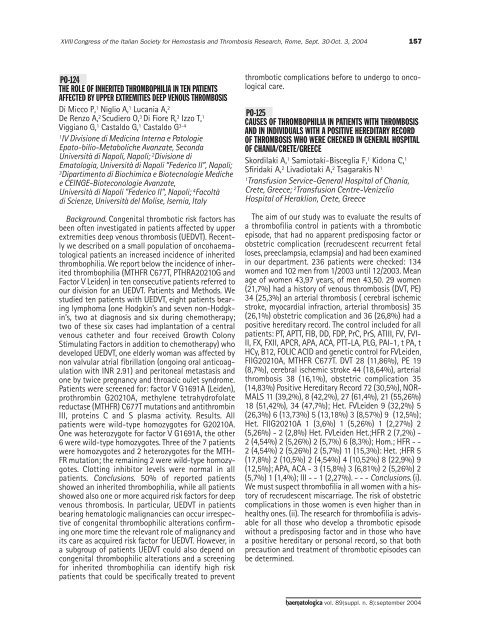Haematologica 2004;89: supplement no. 8 - Supplements ...
Haematologica 2004;89: supplement no. 8 - Supplements ...
Haematologica 2004;89: supplement no. 8 - Supplements ...
- No tags were found...
Create successful ePaper yourself
Turn your PDF publications into a flip-book with our unique Google optimized e-Paper software.
XVIII Congress of the Italian Society for Hemostasis and Thrombosis Research, Rome, Sept. 30-Oct. 3, <strong>2004</strong>157PO-124THE ROLE OF INHERITED THROMBOPHILIA IN TEN PATIENTSAFFECTED BY UPPER EXTREMITIES DEEP VENOUS THROMBOSISDi Micco P, 1 Niglio A, 1 Lucania A, 2De Renzo A, 2 Scudiero O, 3 Di Fiore R, 3 Izzo T, 1Viggia<strong>no</strong> G, 1 Castaldo G, 1 Castaldo G 3-41IV Divisione di Medicina Interna e PatologieEpato-bilio-Metaboliche Avanzate, SecondaUniversità di Napoli, Napoli; 2 Divisione diEmatologia, Università di Napoli “Federico II”, Napoli;3Dipartimento di Biochimica e Biotec<strong>no</strong>logie Medichee CEINGE-Bioteco<strong>no</strong>logie Avanzate,Università di Napoli "Federico II", Napoli; 4 Facoltàdi Scienze, Università del Molise, Isernia, ItalyBackground. Congenital thrombotic risk factors hasbeen often investigated in patients affected by upperextremities deep ve<strong>no</strong>us thrombosis (UEDVT). Recentlywe described on a small population of oncohaematologicalpatients an increased incidence of inheritedthrombophilia. We report below the incidence of inheritedthrombophilia (MTHFR C677T, PTHRA20210G andFactor V Leiden) in ten consecutive patients referred toour division for an UEDVT. Patients and Methods. Westudied ten patients with UEDVT, eight patients bearinglymphoma (one Hodgkin’s and seven <strong>no</strong>n-Hodgkin’s,two at diag<strong>no</strong>sis and six during chemotherapy;two of these six cases had implantation of a centralve<strong>no</strong>us catheter and four received Growth ColonyStimulating Factors in addition to chemotherapy) whodeveloped UEDVT, one elderly woman was affected by<strong>no</strong>n valvular atrial fibrillation (ongoing oral anticoagulationwith INR 2.91) and peritoneal metastasis andone by twice pregnancy and throacic oulet syndrome.Patients were screened for: factor V G1691A (Leiden),prothrombin G20210A, methylene tetrahydrofolatereductase (MTHFR) C677T mutations and antithrombinIII, proteins C and S plasma activity. Results. Allpatients were wild-type homozygotes for G20210A.One was heterozygote for factor V G1691A, the other6 were wild-type homozygotes. Three of the 7 patientswere homozygotes and 2 heterozygotes for the MTH-FR mutation; the remaining 2 were wild-type homozygotes.Clotting inhibitor levels were <strong>no</strong>rmal in allpatients. Conclusions. 50% of reported patientsshowed an inherited thrombophilia, while all patientsshowed also one or more acquired risk factors for deepve<strong>no</strong>us thrombosis. In particular, UEDVT in patientsbearing hematologic malignancies can occur irrespectiveof congenital thrombophilic alterations confirmingone more time the relevant role of malignancy andits care as acquired risk factor for UEDVT. However, ina subgroup of patients UEDVT could also depend oncongenital thrombophilic alterations and a screeningfor inherited thrombophilia can identify high riskpatients that could be specifically treated to preventthrombotic complications before to undergo to oncologicalcare.PO-125CAUSES OF THROMBOPHILIA IN PATIENTS WITH THROMBOSISAND IN INDIVIDUALS WITH A POSITIVE HEREDITARY RECORDOF THROMBOSIS WHO WERE CHECKED IN GENERAL HOSPITALOF CHANIA/CRETE/GREECESkordilaki A, 1 Samiotaki-Bisceglia F, 1 Kidona C, 1Sfiridaki A, 2 Livadiotaki A, 2 Tsagarakis N 11Transfusion Service-General Hospital of Chania,Crete, Greece; 2 Transfusion Centre-VenizelioHospital of Heraklion, Crete, GreeceThe aim of our study was to evaluate the results ofa thrombofilia control in patients with a thromboticepisode, that had <strong>no</strong> apparent predisposing factor orobstetric complication (recrudescent recurrent fetalloses, preeclampsia, eclampsia) and had been examinedin our department. 236 patients were checked: 134women and 102 men from 1/2003 until 12/2003. Meanage of women 43,97 years, of men 43,50. 29 women(21,7%) had a history of ve<strong>no</strong>us thrombosis (DVT, PE)34 (25,3%) an arterial thrombosis ( cerebral ischemicstroke, myocardial infraction, arterial thrombosis) 35(26,1%) obstetric complication and 36 (26,8%) had apositive hereditary record. The control included for allpatients: PT, APTT, FIB, DD, FDP, PrC, PrS, ATIII, FV, FVI-II, FX, FXII, APCR, APA, ACA, PTT-LA, PLG, PAI-1, t PA, tHCy, B12, FOLIC ACID and genetic control for FVLeiden,FIIG20210A, MTHFR C677T. DVT 28 (11,86%), PE 19(8,7%), cerebral ischemic stroke 44 (18,64%), arterialthrombosis 38 (16,1%), obstetric complication 35(14,83%) Positive Hereditary Record 72 (30,5%), NOR-MALS 11 (39,2%), 8 (42,2%), 27 (61,4%), 21 (55,26%)18 (51,42%), 34 (47,7%); Het. FVLeiden 9 (32,2%) 5(26,3%) 6 (13,73%) 5 (13,18%) 3 (8,57%) 9 (12,5%);Het. FIIG20210A 1 (3,6%) 1 (5,26%) 1 (2,27%) 2(5,26%) - 2 (2,8%) Het. FVLeiden Het.;HFR 2 (7,2%) -2 (4,54%) 2 (5,26%) 2 (5,7%) 6 (8,3%); Hom.; HFR - -2 (4,54%) 2 (5,26%) 2 (5,7%) 11 (15,3%): Het. ;HFR 5(17,8%) 2 (10,5%) 2 (4,54%) 4 (10,52%) 8 (22,9%) 9(12,5%); APA, ACA - 3 (15,8%) 3 (6,81%) 2 (5,26%) 2(5,7%) 1 (1,4%); III - - 1 (2,27%). - - - Conclusions. (i).We must suspect thrombofilia in all women with a historyof recrudescent miscarriage. The risk of obstetriccomplications in those women is even higher than inhealthy ones. (ii). The research for thrombofilia is advisablefor all those who develop a thrombotic episodewithout a predisposing factor and in those who havea positive hereditary or personal record, so that bothprecaution and treatment of thrombotic episodes canbe determined.haematologica vol. <strong>89</strong>(suppl. n. 8):september <strong>2004</strong>
















